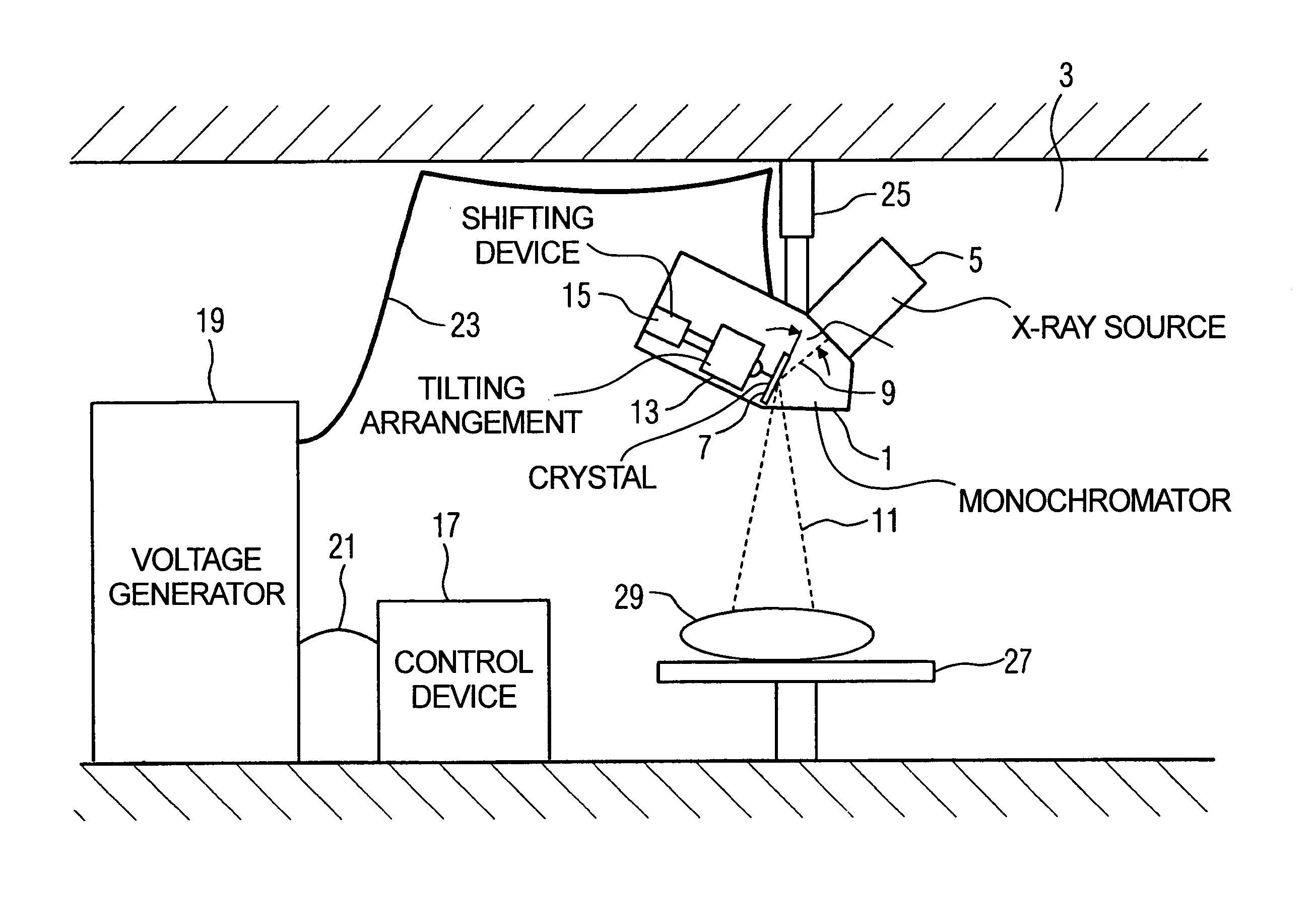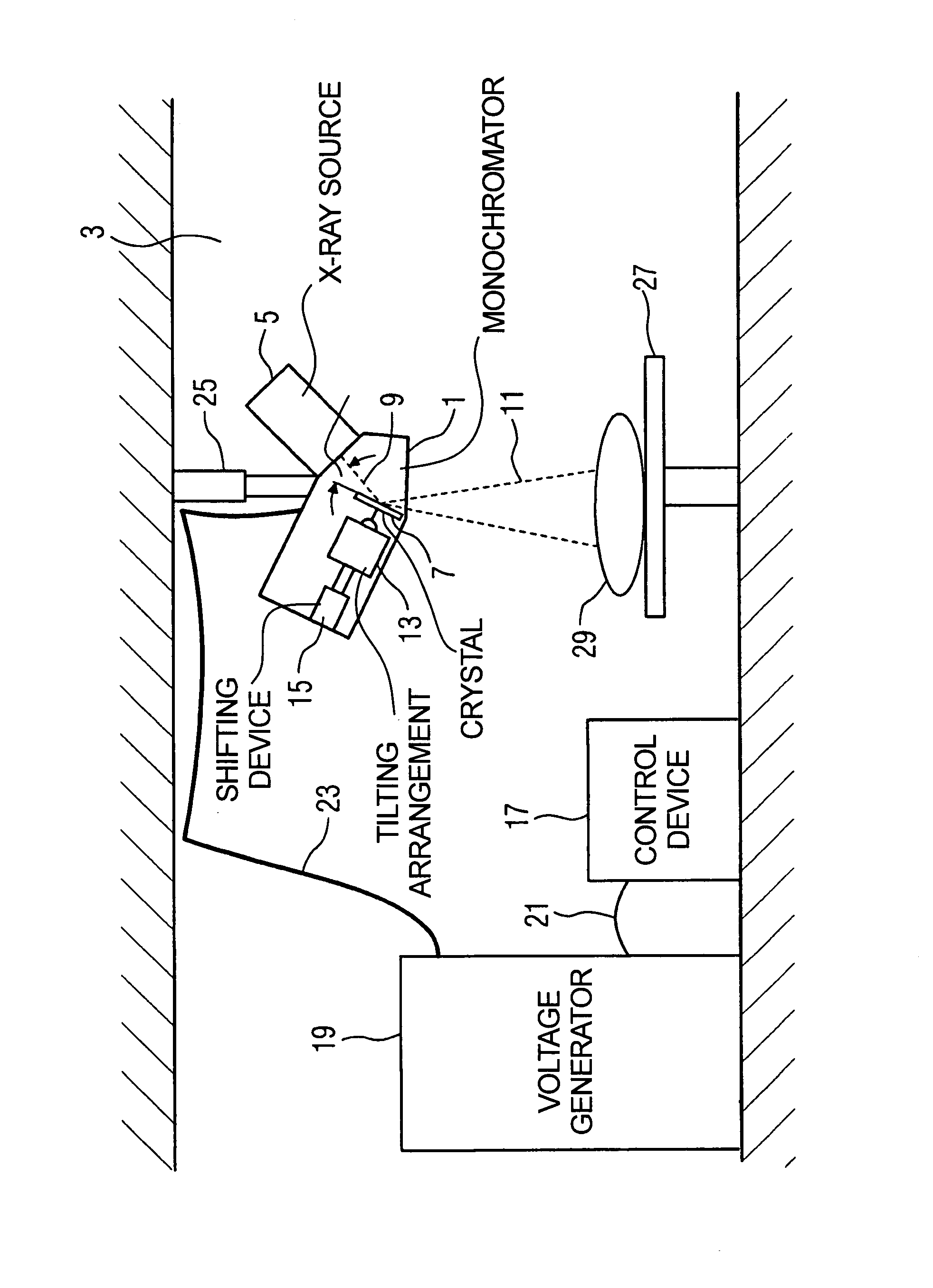[0009]An object of the present invention is to provide a monochromator for an X-ray device that makes it possible to variably spectrally
restrict X-rays produced by an X-ray device using a reflection crystal, with such a monochromator being inexpensive to design and easy to operate.
[0010]The above object is achieved in accordance with the present invention by a monochromator for an X-ray device that comprises an X-ray source with a crystal for spectral restriction of the X-ray produced by the X-ray source, wherein, according to the invention, the crystal can be adjusted by a positioning device so that the
energy spectrum of the spectrally restricted X-radiation can be changed. The ability to adjust the crystal provides the possibility of adjusting the
energy spectrum of the spectrally restricted X-radiation to comply with the requirements for the image to be acquired without having to set the X-ray
voltage and X-ray tube current to non-optimal values. For example, using this design the blooming effect that occurs at low X-ray voltages and high X-ray currents can be avoided, or the X-ray tube can always be operated with an X-ray
voltage suitable for the particular requisite level of efficiency. At the same time, the adjustability of the crystal allows for a variable adjustment of the energy spectrum to various requirements without the need for changes in the X-ray source (for example, in the
anode material).
[0012]In an embodiment of the invention, the crystal is adjustable so that the angle between the X-rays (produced by the X-ray source) and the crystal can be changed. According to the Bragg relation, the energy spectrum of the spectrally restricted X-radiation changes dependent on the change of the
diffraction angle. Therefore, the ability to change the angle provides a simple and inexpensive means of producing X-radiation with variable energy spectra. Greater changes in the angle, which can be achieved, for example, by tilting the crystal, change the entire X-ray path. However, such changes can be simply compensated for, e.g., by a simultaneous tilting of the X-ray source. The tilting of the crystal performed together with a coordinated tilting of the X-ray source allows for a simple continuous variation of the energy spectrum of X-radiation with an unchanged X-ray path.
[0013]In another embodiment of the invention, the crystal can be adjusted so that it can be fully removed from and returned into the X-ray path produced by the X-ray source. If the crystal is removed from the X-ray path, Bragg
diffraction of the X-ray is prevented, and the original energy spectrum of the X-ray source is reconstituted. Thus, the option of removing and then returning the crystal to the X-ray path provides a simple way of producing either spectrally restricted X-rays or X-rays without any spectral restriction. If, during the removal of the crystal, certain adjustments have to be made to reflect the change in the entire X-ray path, for example, by tilting the X-ray source, this is easy to do.
[0014]In another embodiment of the invention, the crystal can be automatically adjusted so that we reach a maximum value of the energy spectrum of the spectrally restricted X-radiation is reached that is between 0.34- and 0.8-multiples of the maximum value of the original (unrestricted) energy spectrum of the X-ray source. The original energy, which is greater than in the spectrally restricted X-radiation, is produced by an increased X-ray voltage, which means the blooming effect is reduced. At the same time, by maintaining a minimal factor of about 0.34, the influence of higher-order reflection in the energy spectrum of the spectrally restricted X-radiation is minimized. Higher-order reflection occurs at double, triple, quadruple, etc. the minimum value of the original X-radiation. The indicated range rules out the possibility that reflections from the 3rd order and beyond will be contained in the spectrally restricted X-radiation.
 Login to View More
Login to View More  Login to View More
Login to View More 


